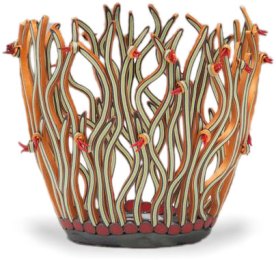
Pennsylvania’s Emily Squires Levine used her Artchain Challenge to show us these Then & Now works. Inspired by Karin Noyes’ polymer bowls, Emily formed her first version in the mid-1990’s around a custard dish. It drooped when she removed the warm clay from the form but she was undeterred.
Fast forward to this fall and you’ll see how far Emily has come. In fall 2014 she created a flower pot of wavy tendrils in muted greens and metallic golds, part of her Sargassum series that appeared in the Racine Art Museum exhibit.

Emily’s bowls, eggs and tiles depend on her own strong color palette and exploit the negaitve spaces between elements.
Browsing through her galleries of bowls and polymer/resin tiles on her site and photos on Facebook and Flickr may set you off on your own journey of exploration.
Be sure to keep a photo of your first efforts!

Kathy R. ,
Stunning work! It challenges and stretches our concept of “bowl”. And yes it gives me lots of inspiration!
Ronna ,
Emily did a very brave and unselfish thing: She used the Art Challenge to showcase an early piece to give others that dose of inspiration that comes from understanding that accomplished artists don’t get there in a day. I’m percolating about some sort of collaboration where we can all share our befores and afters. Often it’s years and years between the first manifestation of the idea and the eventual graceful work of art. And oh boy are her bowls graceful!
Annie Pennington ,
Ooh, Ronna. I love that idea. It’s always a good idea to photograph everything!
Jo Nortcliff ,
There’s hope for me yet. I showed this to my partner and he chuckled, as my first attempt at a PC spiral bowl only a few weeks ago didn’t look as good Karin’s first attempt, but in light of her progress I shall persevere.
Sue Ellen ,
I love Emily’s work AND I love Ronna’s idea of sharing a “before and after.” I think the evolution of our work is as beautiful as the work itself.